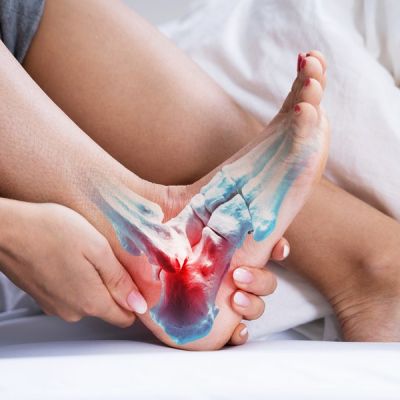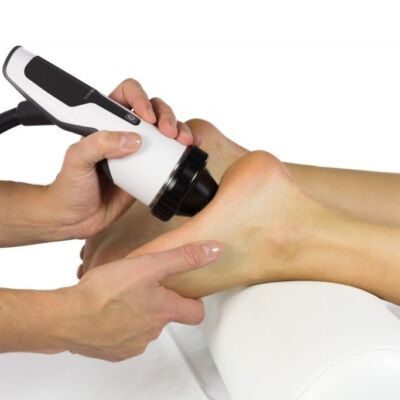Heel Spur Syndrome Treatment Options
As board certified foot and ankle specialists, heel pain is the most common condition we see. Heel spur syndrome, also known as Plantar Fasciitis, is a chronic, overuse type injury that occurs in people of all shapes and sizes, of all ages and activity levels. It most commonly develops without an injury and results in significant pain in the heel or arch of the foot which can be debilitating. Fortunately, heel spur syndrome can usually be treated conservatively without the need for surgery. In some rare cases, heel spur surgery may be necessary but it is performed as an outpatient procedure and patients go home the same day.
Symptoms of Heel Spur Syndrome
Patients with Plantar Fasciitis or heel spurs usually complain of pain in the bottom of the heel which is worse after rest, or in the morning when they first get out of bed. This is because the underlying problem is tightness of the plantar fascia, or the ligament on the bottom of the foot. When we’re off our feet, the ligament tightens up. When we stand, especially without proper support, the fascia is put under tension, and if not flexible enough, it will pull on the heel bone where it attaches. This causes severe pain and inflammation, and can eventually tear the ligament. Further, the constant tension on the bone causes new bone to form in the shape of a spur on the bottom of the heel. Despite popular belief, the heel spur itself, when on the bottom of the foot, does not cause pain – the tight ligament causes the pain, which can have a severe impact on the patients’ activity levels and even their ability to walk!
Conservative Treatment for Heel Spur Syndrome
Heel spur syndrome or Plantar Fasciitis often resolves with conservative treatment, and surgery is not typically required. Treatment for heel pain usually consists of stretching, arch support and anti-inflammatory medicine. Proper stretching is done by keeping the knee straight and pulling the foot back toward the leg. One will feel the stretch in the bottom of the foot and the calf muscle as well. Arch support must be rigid to be effective in preventing excessive pull of the ligament on the heel bone. Most over the counter insoles do not provide adequate support to treat this condition. While oral anti-inflammatories such as Advil, Aleve or Motrin may be effective, Cortisone injections provide more immediate and effective relief. For cases of partially torn, degenerated fascia, Amniotic Fluid Injections may be used by the Podiatrists at Certified Foot and Ankle Specialists for treatment, which is a strong anti-inflammatory, to accelerate healing. PRP( Platelet Rich Plasma) therapy and Stem Cell injections are options as well, but in our experience are less effective than Amniotic Fluid for this condition.
Heel Spur Surgery
Surgery may be indicated in the rare case of Plantar Fasciitis which does not respond to conservative treatment. In our experience, the most effective heel spur surgery is the Endoscopic Plantar Fasciotomy, or EPF. This “per cutaneous procedure” or minimally invasive procedure is performed under anesthesia in a surgery center or hospital as an outpatient. It takes approximately 15 minutes. A small camera is introduced through a tiny incision in the heel and the instrument through another small incision on the other side of the foot. Under visualization through the scope, the ligament is released which gets rid of the tension on the bone, which is causing the pain. Stitches remain for 2 weeks and patients return to activity as tolerated. Success rates are excellent and complication rates are low. Some Podiatrists may recommend open surgery with large incisions to release the fascia or remove the heel spur, but this is not necessary in the vast majority of cases.

Stress Fracture, Tarsal Tunnel Syndrome and Medial Calcaneal Nerve Entrapment
If heel pain is not responding to conservative treatment, there is most likely something else causing the pain, in addition to plantar fasciitis or heel spur syndrome. Most often, the culprit is underlying nerve entrapment. The posterior tibial nerve and its branch to the heel, the medial calcaneal nerve, may be compressed in the “tarsal tunnel”. Your foot and ankle specialist should be able to diagnose this with a physical exam and possibly using nerve conduction studies. If found to be present, tarsal tunnel syndrome typically requires surgery to relieve the pressure on the nerve, and over 80% of the time, the pain will go away.
Another cause of pain in the heel which does not respond to treatment for plantar fasciitis is a calcaneal stress fracture. This pain can be reproduced by squeezing the heel and shows up on an MRI, not an x-ray. Treatment for a stress fracture in the heel bone is treated with prolonged non-weight bearing.
Haglunds Deformity or Retrocalcaneal Exostosis
Another condition that may be referred to as a heel spur is Haglunds Deformity, which is closely related to and often confused with Retrocalcaneal Exostosis or Calcified Insertional Achilles Tendonitis. This condition presents with pain in the back of the heel, not the bottom. Often in the case of Haglunds Deformity, there is a large prominence, or bone spur, on the back of the heel which is very painful in most shoes. Unfortunately, a spur on the back of the heel does not usually respond to conservative treatment and often requires surgery to remove the prominent, painful spur.
HEEL SPUR SYNDROME
As you can see, while most cases of heel pain (90%) respond to conservative treatment, there are subtle differences in diagnoses which require dramatically different treatments in order to relieve pain and help you return to normal activity. Therefore, it is of utmost importance to see a Board Certified Foot and Ankle Surgeon as soon as heel pain develops in order to prevent further injury! Make an appointment at one of our seven South Florida locations today!




